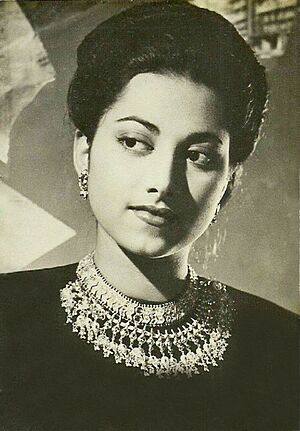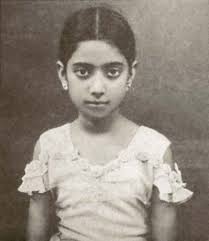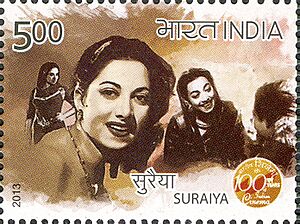Suraiya facts for kids
Quick facts for kids
Suraiya
|
|
|---|---|

Suraiya, c. 1949
|
|
| Pronunciation | Su-rai-yaa |
| Born |
Suraiya Jamal Sheikh
15 June 1929 |
| Died | 31 January 2004 (aged 74) |
| Resting place | Bada Qabrastan, Marine Lines, Mumbai, Maharashtra, India |
| Occupation |
|
| Years active | 1936–1964 |
|
Notable work
|
Tadbir (1943) Phool (1945) Anmol Ghadi (1946) Dard (1947) Vidya (1948) Pyar Ki Jeet (1948) Dillagi (1949) Badi Behen (1949) Afsar (1950) Mirza Ghalib (1954) Rustam Sohrab (1963) |
| Partner(s) | Dev Anand (1948–1951) |
| Signature | |
 |
|
Suraiya Jamal Sheikh (born June 15, 1929 – died January 31, 2004), known simply as Suraiya, was a famous Indian actress and singer. She worked in Hindi films for many years, from 1936 to 1964. During her career, Suraiya acted in over 70 films and sang 338 songs.
Many people consider her one of the greatest actresses in the history of Indian cinema. She was known for her strong characters on screen. In the mid-1940s and early 1950s, Suraiya was a top star. She even earned more money than her male co-stars!
Suraiya was born in Lahore, which is now in Pakistan. When she was just one year old, her family moved to Mumbai (then called Bombay). Besides being a great actress, Suraiya was also a talented singer. She mostly sang her own songs in films. Her first song was for the film Nai Duniya (1942) when she was only 12.
She first appeared as a child artist in Madame Fashion (1936). Her official acting debut was in 1941, playing Mumtaz Mahal in Taj Mahal. Suraiya became a leading actress with many successful films. These included Tadbir (1943), Phool (1945), Anmol Ghadi (1946), Pyar Ki Jeet (1948), Dillagi (1949), and Mirza Ghalib (1954).
During her most famous years, people called Suraiya Malika-e-Husn (queen of beauty) and Malika-e-Adakari (queen of acting). Her role in Mirza Ghalib (1954) was especially praised. Even two Prime Ministers of India complimented her performance.
Suraiya's last film was Rustam Sohrab (1963). She retired from acting because of health issues. In 1996, she received the Screen Lifetime Achievement Award for her amazing work in Indian cinema. Suraiya passed away on January 31, 2004, at the age of 75.
Contents
Her Early Life
Suraiya Jamal Sheikh was born on June 15, 1929, in Lahore, British India. Her parents were Aziz Jamal Sheikh and Mumtaz Sheikh. When she was one year old, her family moved to Mumbai (then called Bombay). They lived in a place called Krishna Mahal near Marine Drive.
Her uncle, M. Zahoor, who became a well-known villain in films, and her grandmother, Badshah Begum, also joined them. Suraiya grew up in a religious Muslim family. She went to New High School, which is now J.B. Petit High School for Girls, in Mumbai. At home, her grandmother taught her religious lessons in Persian.
Suraiya had childhood friends like Raj Kapoor and Madan Mohan. They used to sing together in children's radio shows at All India Radio. Suraiya never had any official music training. She loved to read, especially Urdu literature.
Starting Her Acting Journey
Becoming a Child Star
Suraiya started her acting career as a child in 1936. Her first film was Madame Fashion. Later, her uncle, M. Zahoor, helped her get a bigger role. In 1941, during a school holiday, she went with him to a film set. The director, Nanubhai Vakil, noticed young Suraiya. He chose her to play Mumtaz Mahal in the film Taj Mahal. This film, released in 1942, was her official acting debut.
When she was six, Suraiya sang for children's programs at All India Radio (AIR) in Bombay. Raj Kapoor and Madan Mohan were also there. They were the ones who first introduced her to AIR. Later, they worked with her as adults in films. Music director Naushad Ali heard Suraiya's voice and chose her to sing for actress Mehtab in Sharda (1942). Suraiya was only 13 at the time. Naushad became her mentor, and she sang many of her best songs with him.
As a child artist, Suraiya also acted and sang in films like Usne Kya Socha (1937) and Mother India (1938).
Rising to Fame
In 1943, at age 14, Suraiya played a main role in Ishaara, opposite Prithviraj Kapoor. This film was a big success. Devika Rani, who ran the Bombay Talkies film company, saw Suraiya's talent. She signed Suraiya for a five-year contract. Suraiya then played a role in Hamari Baat (1943). Her song "Bistar Bicha Diya Hai Tere Ghar Ke Samne" from this film became very popular.
The year 1945 was very important for Suraiya. She had five films released, including Yateem and Samrat Chandragupta. K. Asif offered Suraiya a large amount of money for his film Phool. She played Shama in this film. Suraiya also worked with the famous singer and actor K. L. Saigal for the first time in Tadbir. He liked her voice and suggested her for the role. Both Phool and Tadbir were very successful films that year.
In 1946, Suraiya starred in 1857 and Anmol Ghadi. In Anmol Ghadi, she played a lively village girl named Basanti. Even though Noor Jehan was also in the film, Anmol Ghadi was a major breakthrough for Suraiya. She also reunited with K. L. Saigal in Omar Khaiyyam. These films were among the highest-grossing movies of the year and made Suraiya a big star.
In 1947, the year India became independent, Suraiya had five films released. She sang four solo songs in Parwana, which made her a true singing film star. This was her last film with Saigal, who passed away before its release. Her film Dard was also a big hit.
Becoming a Superstar
When actresses like Noor Jehan and Khursheed left for Pakistan, it helped Suraiya's career grow even more. From 1948 to 1950, Suraiya achieved huge success. In 1948, she starred opposite Dev Anand for the first time in Vidya. She played a rich woman who falls in love with a poor cobbler. During the filming of Vidya, they became romantically involved.
When her film Pyar Ki Jeet was released, huge crowds gathered outside Suraiya's house. This showed just how popular she was. In her films with Dev Anand, Suraiya was always the top-billed star, showing her high status.
The year 1949 was the peak of Suraiya's success. She had 11 film releases, which was very rare for an actress back then. She reunited with Dev Anand in Jeet and Shair. Her film Dillagi was a major success. Her last film of the year was Badi Behen, where she played a protective older sister. At the premiere of Badi Behen, the crowd was so large that police had to step in. After this, Suraiya stopped attending her film premieres. Dillagi, Badi Behen, and Singaar were the biggest hits of 1949.
In 1950, Suraiya continued her success. She acted opposite Dev Anand in Nilli and Afsar. Her biggest hit that year was Dastan, where she starred opposite Raj Kapoor. From the mid-1940s to the early 1950s, Suraiya was the highest-paid and most popular star in Indian cinema.
Between 1951 and 1953, some of Suraiya's films were not as successful. However, Diwana was a big hit. In 1954, Suraiya made a strong comeback. She starred in Mirza Ghalib, which won two national film awards. Suraiya was praised for her acting and singing in this film. The Prime Minister, Jawaharlal Nehru, even said she "brought the soul of Mirza Ghalib back to life."
Later Career and Retirement
After 1954, Suraiya started to work less often. In 1956, she starred in Mr. Lambu, which was a box office hit. She appeared in a few more films in 1958 and 1961.
Her last film was Rustam Sohrab in 1963, where she acted with Prithviraj Kapoor. Suraiya played a princess named Shehzadi Tahmina. In an interview, Suraiya said she retired from acting because of low blood pressure during filming. Her song "Ye kaisi ajab dastan ho gayi hai" from this film is still very popular.
Suraiya's last involvement in films was in 1964 when she produced the film Shagoon. For her contributions to Indian cinema, Suraiya received the Screen Lifetime Achievement Award in 1996. She also received the Bimal Roy Memorial Lifetime Achievement Award in 1999.
Her Amazing Singing Career
Suraiya is known as the first actor-singer of independent India. Many people called her the most popular singing superstar. She started singing as a child for the film Nai Duniya (1942). The music was by Naushad. She also sang for actress Mehtab in films like Sharda (1942).
Suraiya sang her first Hindi film duet with Manna Dey in Tamanna (1942). In 1943, she sang a unique song in Kanoon that had Latin American music elements. Her duet with Arun Kumar, "Bistar Bicha Liya Hai Tere Dar Ke Samne", from Hamari Baat (1943) was a big hit.
A few years later, the famous singer-actor K.L. Saigal was very impressed by Suraiya's singing. He chose her to act and sing opposite him in Tadbir (1945). Their song "Rani khol de dawar milne ka din aa gaya" is still remembered. Saigal also chose her for his films Omar Khayyam (1946) and Parwana (1947).
Suraiya continued to work with music director Naushad. In 1946, she starred with Noor Jehan in Anmol Ghadi. She sang three popular songs in this film, including 'Man leta hai angdai'. The musical film Dillagi (1949) was a huge success, and Suraiya became a national sensation with her songs and acting. She sang about 51 songs for Naushad.
Some of Suraiya's other hit songs include "Woh paas rahen ya door rahen", "Tere nainon ne chori kiya", and "Tu mera chand, main teri chandni". She worked with many other music directors throughout her career. These included Husnlal Bhagatram, Sachin Dev Burman, and Ghulam Mohammad. Ghulam Mohammad composed music for her most famous film, Mirza Ghalib (1954).
Her Personal Life
Her Relationship with Dev Anand
Suraiya had a relationship with actor Dev Anand for four years, from 1948 to 1951. Dev Anand called her "Nosey," and she called him "Steve." They also had fun nicknames like "Devina" for him and "Suraiyana" for her. Kamini Kaushal, who worked with them, said Suraiya would pass her letters to her to give to Anand. This was because Suraiya's grandmother was watching their relationship closely.
During the filming of Jeet (1949), Suraiya and Anand planned to get married secretly. But at the last moment, an assistant director told Suraiya's grandmother. She pulled Suraiya away from the scene. Later, while filming Afsar (1950), Dev Anand proposed to her and gave her a diamond ring.
Suraiya's grandmother was strongly against her marrying Anand. This was mainly because Suraiya was Muslim and Anand was Hindu. Also, Suraiya was the main person earning money for her family. Her grandmother, uncle, and some film industry people supported this opposition.
After their last film together in 1951, Suraiya and Anand were stopped from working together. Suraiya chose to remain unmarried for the rest of her life. In an interview, she said she didn't have the courage to go against her family. She also said that Anand truly loved her. Dev Anand later married Kalpana Kartik in 1954. He wrote in his autobiography that Suraiya was his "first true love."
Her Friends in the Film World
While working as a child artist at All India Radio, Suraiya became friends with Raj Kapoor and Madan Mohan. She had good relationships with many people in the film industry. She was friends with Paidi Jairaj, Nimmi, Nirupa Roy, Tabassum, and lyricist Hasan Kamal.
Suraiya had a very close bond with composer Naushad, whom she saw as her mentor. Naushad said that after she left the film industry, Suraiya kept her circle of friends small. She only met a few people sometimes.
Her Later Years and Legacy
In 1963, Suraiya retired from acting. This was partly because her father, Aziz Jamal Sheikh, passed away that year. She also had health problems. After her father's death, Suraiya lived with her mother, Mumtaz Begum. She occasionally met her friends from the industry.
After her mother died in 1987, Suraiya became quite lonely. She had lived in Krishna Mahal, Marine Drive, since the 1940s.
Suraiya passed away at Harkishandas Hospital in Mumbai on January 31, 2004. She was 75 years old and had been suffering from several health issues. Many people from the film industry, including Sunil Dutt and Naushad, visited her. Actor Dharmendra, who was a big fan, attended her funeral. She was buried in Badakabarastan in Mumbai.
On her death, Dev Anand said he felt sad and cried from a distance. He later wrote about his time with Suraiya in his autobiography. Dilip Kumar remembered Suraiya as a "caring girl, very affectionate."
In May 2013, a postage stamp with Suraiya's image was released by the Government of India. This was to honor her for her contributions to Indian Cinema's 100 years. Her songs are played every year on her birthday and death anniversary by Radio Ceylon. Many books and shows have also paid tribute to her.
The Tribune newspaper wrote that Suraiya "had the world at her feet." Outlook magazine said that in the late 1940s, she caused such excitement that people would skip work or school to see her films on the first day. The Hindu newspaper described her as "the best ever superstar singer-actress of Indian films."
Filmography
Awards and Recognition
| Year | Award | Category | Work | Result | Ref. |
|---|---|---|---|---|---|
| 1996 | Screen Awards | Lifetime Achievement Award | Contribution to Indian cinema | Honoured | |
| 1999 | Bimal Roy Memorial Awards | Lifetime Achievement Award | Honoured |



